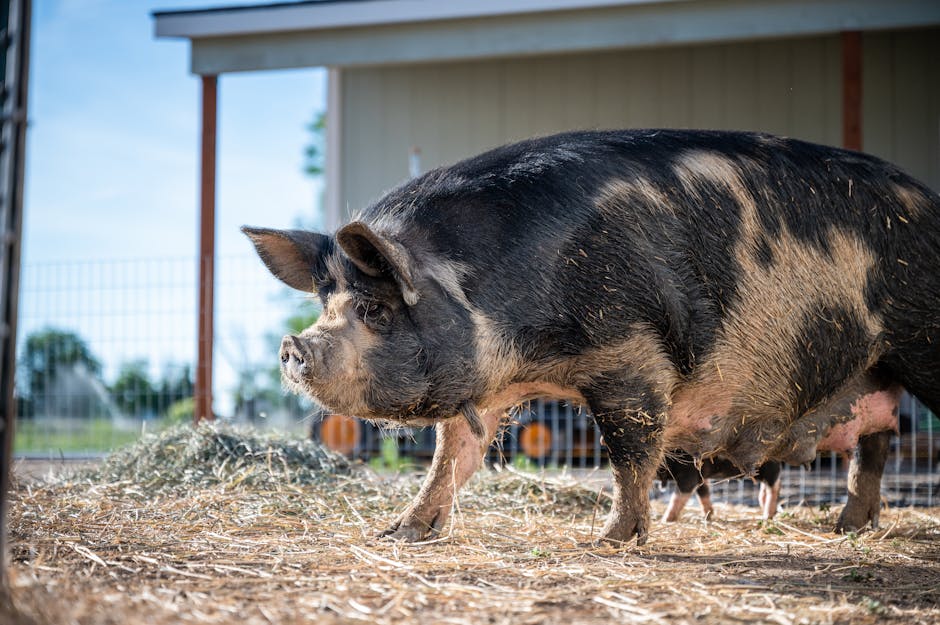Cow Ear Vs. Pig Ear For Dogs
Posted by Derek Lambert on 31st Aug 2023
When it comes to choosing the best treats for our furry friends, the options seem endless. Among the variety of treats available in the market, cow ears and pig ears have gained significant popularity among dog owners. Both cow ears and pig ears are natural treats that provide several benefits for dogs, including dental health, mental stimulation, and a source of protein. However, it is important for pet owners to understand the differences between the two options to make an informed decision. In this article, we will examine the characteristics and advantages of both cow ears and pig ears to help you decide which treat is best suited for your canine companion.
Similarities between Cow Ear and Pig Ear (Origin, Taste, Texture)
When it comes to selecting treats for our furry companions, it's important to consider their tastes and preferences, as well as the health benefits. Cow ears and pig ears are two popular choices among dog owners, and while they may differ in some aspects, they also share several similarities. Let's take a closer look at the origin, taste, and texture of both cow ears and pig ears, providing insight into what makes them equally appealing to our canine friends.
Origin: Both cow ears and pig ears are sourced from animals typically raised for consumption. Cow ears are derived from cattle, such as cows or steers, while pig ears obviously come from pigs. These animal by-products are collected, cleaned, and thoroughly processed to ensure their safety as pet treats. It's important to note that high-quality cow and pig ears for dogs are sourced from reputable suppliers who follow strict quality standards and prioritize animal welfare.
Taste: While dogs might not be able to articulate their flavor preferences, their enthusiastic wagging tails and eager anticipation speak volumes. Both cow ears and pig ears offer a rich, meaty taste that dogs find irresistible. The natural flavors of both treats are well-received, making them a delectable option for rewarding good behavior or simply providing a satisfying chewing experience. It ultimately comes down to individual preferences and what your furry friend finds most enticing.
Texture: The texture of cow ears and pig ears is perhaps one of their most appealing attributes for dogs. Both treats are firm and dense, offering a challenging yet enjoyable chewing experience. Dogs naturally have an instinctual urge to chew, and cow ears and pig ears provide a satisfying outlet for this behavior. The firmness of these treats promotes dental health and helps to remove plaque and tartar buildup, contributing to better oral hygiene for our four-legged friends.
In conclusion, cow ears and pig ears may have different origins, but when it comes to taste and texture, they share several similarities. Both treats offer a rich, meaty taste that dogs love, providing a delightful reward or engaging chewing experience. Additionally, their firm textures make them beneficial for oral health, ensuring that our furry companions enjoy not only a tasty snack but also a beneficial one. As always, it's important to make informed choices based on individual dietary needs, preferences, and any specific health concerns your dog may have.
Differences in size (Which one is larger and how does it affect chewing time?)

When it comes to choosing the perfect chew treat for your furry friend, considering the size and chew time is crucial. In the battle of cow ear vs. pig ear for dogs, one notable difference lies in their size, which significantly impacts how much time your dog spends enjoying their chew.
Cow ears tend to be larger in size compared to pig ears. Typically, cow ears are flat and elongated, making them a substantial and robust option for dogs of all sizes. On the other hand, pig ears are generally smaller and more rounded.
The size disparity between cow and pig ears directly influences the chewing time for your pup. Larger cow ears take longer to consume due to their size and density. Dogs might spend a considerable amount of time gnawing and chewing on a cow ear, which is beneficial for their dental health and helps satisfy their natural chewing instincts.
In contrast, pig ears are smaller, making them easier to consume for dogs with a smaller body size or those who prefer a quicker chewing experience. While they may not last as long as cow ears, pig ears still provide an enjoyable and satisfying chewing experience for your furry companion.
Considering your dog's size, preference, and chewing habits is vital when choosing between cow ear and pig ear treats. If you have a larger breed or a strong chewer, a cow ear might be the better option, providing them with a long-lasting chew. However, if you have a smaller dog or one that prefers a shorter but equally satisfying chew, a pig ear may be more suitable.
Ultimately, both cow ears and pig ears can be a healthy and delicious treat option for your canine friend. By understanding the differences in size and how they affect chewing time, you can make an informed decision that ensures your dog's chewing needs are met while keeping their overall well-being in mind.
Nutritional value of cow ear (Protein content, vitamins, and minerals)

Photo by Paparazzi Ratzfatzzi on Pexels
Cow Ear, a High-Quality Nutritional Treat for Dogs
When it comes to providing our furry friends with a delicious and wholesome treat, it's essential to consider the nutritional value. Cow ear, a popular choice among dog owners, not only satisfies their chewing needs but also offers several essential nutrients that contribute to their overall well-being.
Protein Content: Cow ears are an excellent source of protein, an essential macronutrient that plays a crucial role in muscle development, repair, and supporting a healthy immune system. With approximately 90% protein content, these treats provide a substantial amount of this vital nutrient, contributing to the growth and maintenance of your dog's muscles and tissues.
Vitamins: Cow ears are also rich in essential vitamins that promote overall health. They contain high levels of B vitamins, including B12, which aids in neurological function, energy production, and the formation of red blood cells. Additionally, cow ears are a good source of vitamin A, supporting healthy vision, skin, and immune system function.
Minerals: Another advantage of cow ears is their mineral content, which offers numerous benefits for your dog's health. These treats are rich in calcium, a mineral essential for strong bones and teeth. Additionally, cow ears provide minerals like magnesium, phosphorus, and zinc, which contribute to proper muscle function, energy metabolism, and immune system support.
Choosing cow ears as a treat for your dog not only offers a delicious chewing experience but also provides important nutritional value. The high protein content supports muscle development and maintenance, while the vitamins and minerals contribute to overall health and well-being. As always, it is essential to consider your dog's specific dietary needs and consult with your veterinarian before introducing any new treats into their diet.
Stay tuned for the next section, where we will explore the nutritional value of pig ears and compare them to cow ears to help you make an informed decision for your furry friend.
Nutritional value of pig ear (Comparing protein content and nutrient profile with cow ears)

For those pet owners who like to treat their dogs with natural chews, cow ears and pig ears are two popular options to consider. While both options may seem similar at first glance, it's important to look into their nutritional value to make an informed choice for your furry friends.
When comparing the nutritional content of cow ears and pig ears, it's essential to focus on the protein content and overall nutrient profile. Protein is an essential component of a dog's diet as it supports muscle development, tissue repair, and overall growth.
In terms of protein content, cow ears typically have a slightly higher protein concentration compared to pig ears. On average, cow ears contain around 70-80% protein, while pig ears generally have a protein content ranging from 60-70%. However, it's important to note that these values can vary depending on the specific product and the method of preparation.
Apart from protein, both cow ears and pig ears offer various essential nutrients for your dog's well-being. They are a good source of minerals like calcium, phosphorus, and magnesium, which play a vital role in maintaining strong bones and teeth. Additionally, these chews provide healthy fats that can contribute to your dog's overall energy levels and promote a shiny coat.
When considering the nutrient profile, it's worth mentioning that pig ears tend to contain a slightly higher fat content compared to cow ears. While fat is an important part of a dog's diet, excessive intake can lead to weight gain and other health concerns. Therefore, if your dog has specific dietary requirements or is prone to weight gain, it may be advisable to opt for cow ears, which generally have a lower fat content.
Ultimately, the nutritional value of cow ears and pig ears can differ slightly, with cow ears typically having a higher protein content and lower fat content than pig ears. However, it's important to remember that individual dog's dietary needs can vary, so consulting with your veterinarian to determine the best chew option for your pet is always recommended.
In conclusion, when deciding between cow ears and pig ears as dog chews, considering the nutritional value is crucial. While cow ears generally offer slightly higher protein content and lower fat content, both chews can provide valuable nutrients for your furry companion. As with any dietary change, monitoring your dog's response and consulting with a professional is essential to ensure their well-being.
Safety concerns regarding pig ear high fat content

Photo by Brett Sayles on Pexels
When it comes to choosing the perfect chew treat for your furry friend, there are a few factors to consider. One popular choice among pet owners is pig ear treats. However, it is important to be aware of the safety concerns surrounding pig ears, particularly in regard to their high fat content.
A factor to consider when it comes to pig ears is their high fat content. While fat is an essential part of a balanced diet for dogs, excessive amounts can lead to weight gain, obesity, and other related health problems. Pig ears are known for their high fat content and feeding them regularly to your dog can contribute to weight gain, which may lead to other health issues like joint problems and decreased mobility.
If you are concerned about the potential safety risks associated with pig ears, you may want to consider alternative chew treats for your dog. Cow ears, for example, are a popular alternative that provides a similar chewing experience without the same level of safety concerns. Cow ears are generally considered safer due to stricter quality control measures and lower bacterial contamination risk.
Remember, it is essential to prioritize the health and well-being of your furry companion when choosing their chew treats. Always consult with your veterinarian to determine what type of chew treat is most suitable for your dog's individual dietary needs and overall health condition.
Considerations for dogs with specific dietary needs (Low-fat or protein-rich diets)
When it comes to choosing between cow ear and pig ear for dogs with specific dietary needs, it's essential to consider factors such as low-fat or protein-rich diets. Dogs with specific dietary requirements, whether due to weight management or certain health conditions, require careful consideration when selecting treats.
For dogs on a low-fat diet, cow ear may be the better choice. Cow ears generally have lower fat content compared to pig ears, making them a suitable option for overweight or obese dogs. These treats can still provide a satisfying chewing experience for your furry friend while keeping their fat intake under control. However, it's important to note that moderation is key, even with low-fat treats, to ensure overall calorie intake remains within the recommended range.
On the other hand, if your dog requires a protein-rich diet, pig ear might be a more suitable option. Pig ears are typically higher in protein compared to cow ears, making them an excellent choice for dogs that need an extra protein boost. Protein is essential for a dog's overall health and helps support muscle development and repair.
It is crucial to consult with your veterinarian or a veterinary nutritionist before making any significant changes to your dog's diet, including treats. They can provide guidance specific to your dog's needs, taking into account their individual health considerations, age, weight, and activity level.
As with any treats, it is important to monitor your dog while they enjoy cow or pig ears. Dogs have different chewing styles and strengths, and providing appropriate supervision ensures their safety and prevents choking hazards. Additionally, always choose high-quality, natural treats from reputable sources to ensure they are free from harmful additives or contaminants.
Remember, a healthy diet is not solely based on treats but should involve a well-balanced, nutritious meal plan. Treats like cow ear or pig ear should complement a complete and balanced diet tailored to your dog's specific nutritional needs.
In conclusion, when deciding between cow ear and pig ear for dogs with specific dietary needs, it's crucial to consider factors such as low-fat or protein-rich diets. Consulting with your veterinarian and selecting high-quality options are essential steps towards ensuring your dog receives the appropriate treats that align with their dietary requirements.
Considerations for dogs with allergies or sensitivities (Which ear is more hypoallergenic?)

Photo by Matheus Bertelli on Pexels
When it comes to choosing the right type of chew treat for your dog, it's important to consider any allergies or sensitivities your furry friend may have. Some dogs are prone to allergies, particularly to certain proteins found in popular animal-based treats. In this section, we will compare cow ears and pig ears to determine which one is more hypoallergenic for dogs with allergies or sensitivities.
Cow ears are known for their tough texture, making them a long-lasting chewing option for dogs. However, one of the primary considerations for choosing a hypoallergenic treat is the level of potential allergens it contains. Cow ears are generally considered to have a lower risk of causing allergies in dogs compared to pig ears. This is mainly due to the differences in protein composition between the two.
Pig ears, on the other hand, are often favored by dogs due to their palatability and chewy texture. However, they do tend to have a slightly higher risk of triggering allergies or sensitivities in some canines. This is because pig ears contain a higher amount of fat and are more prone to harboring bacteria or contaminants, which can potentially aggravate allergies in susceptible dogs.
To determine which ear is more hypoallergenic for your dog, it is crucial to consult with your veterinarian or conduct an allergy test if your dog has a known sensitivity. Your vet will be able to provide personalized advice and recommend the most suitable option based on your dog's specific needs and allergies.
In addition to considering the hypoallergenic aspect, it's vital to monitor your dog while they enjoy chew treats. If you notice any signs of discomfort, gastrointestinal upset, or an allergic reaction such as excessive itching, redness, or swelling, discontinue the treat immediately and consult your vet.
Remember, every dog is unique, and what works for one may not work for another. By considering the potential allergenic properties of the treats you choose, you can provide your furry friend with a safe and enjoyable chewing experience while minimizing the risk of allergic reactions or sensitivities.
